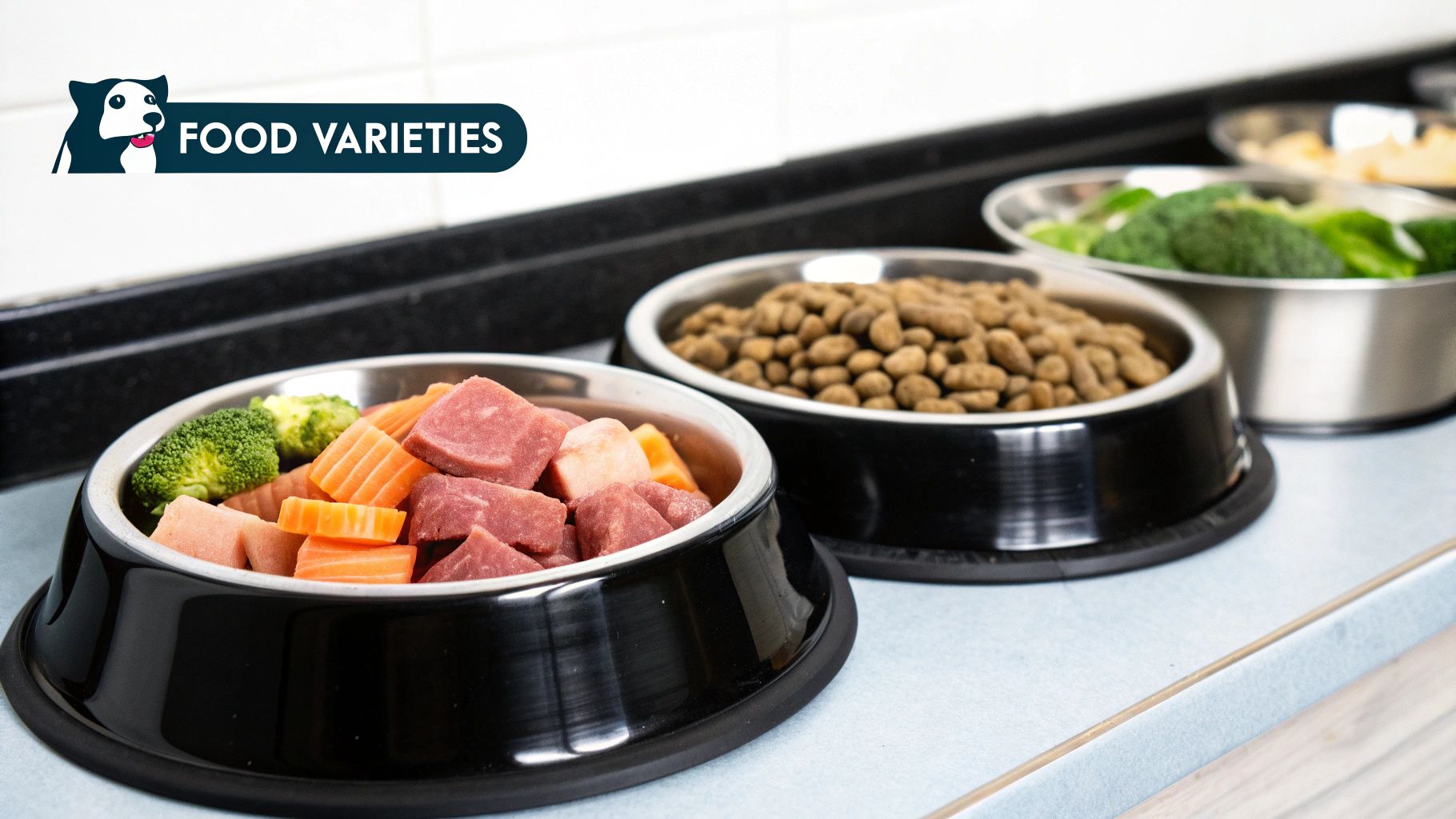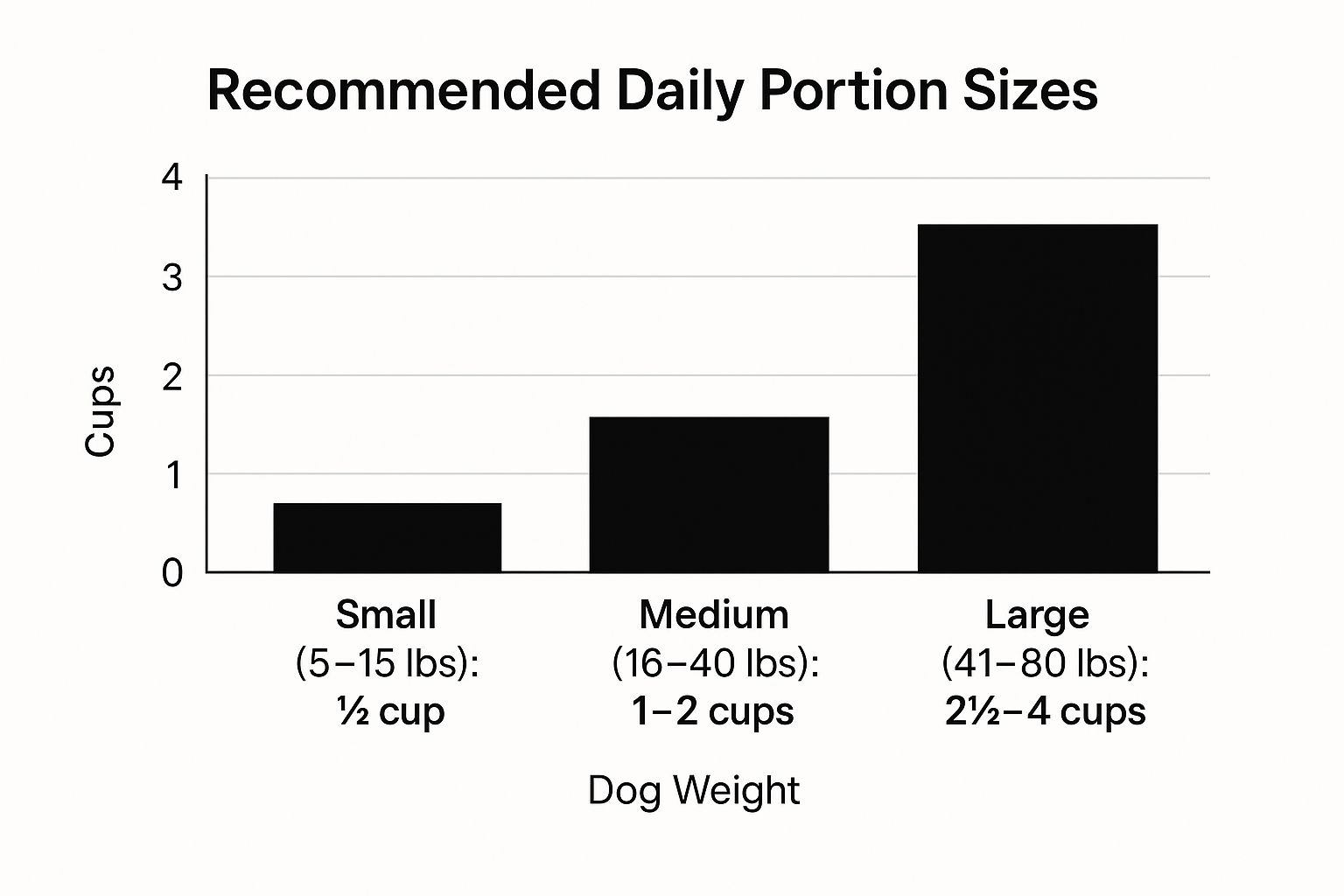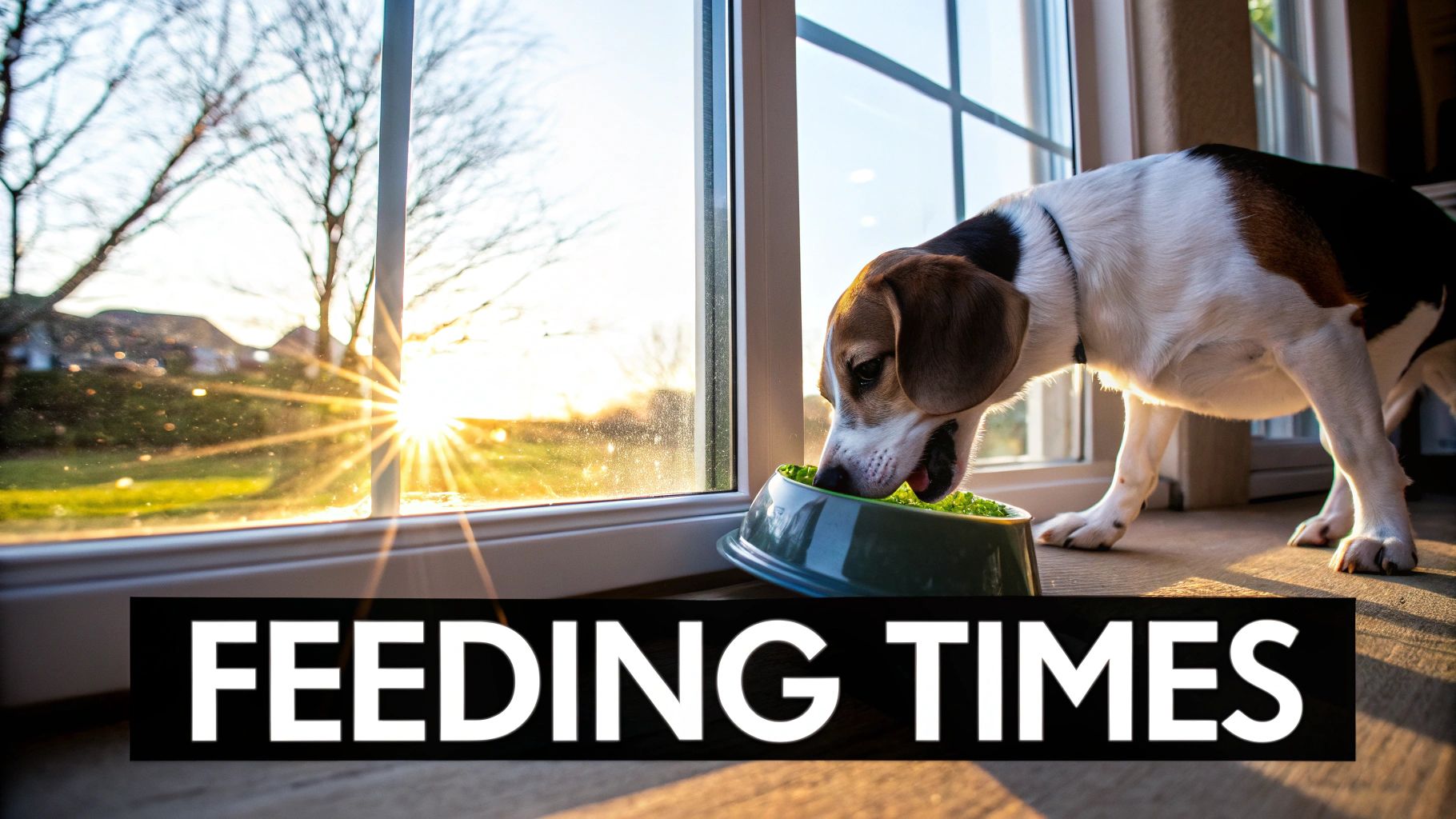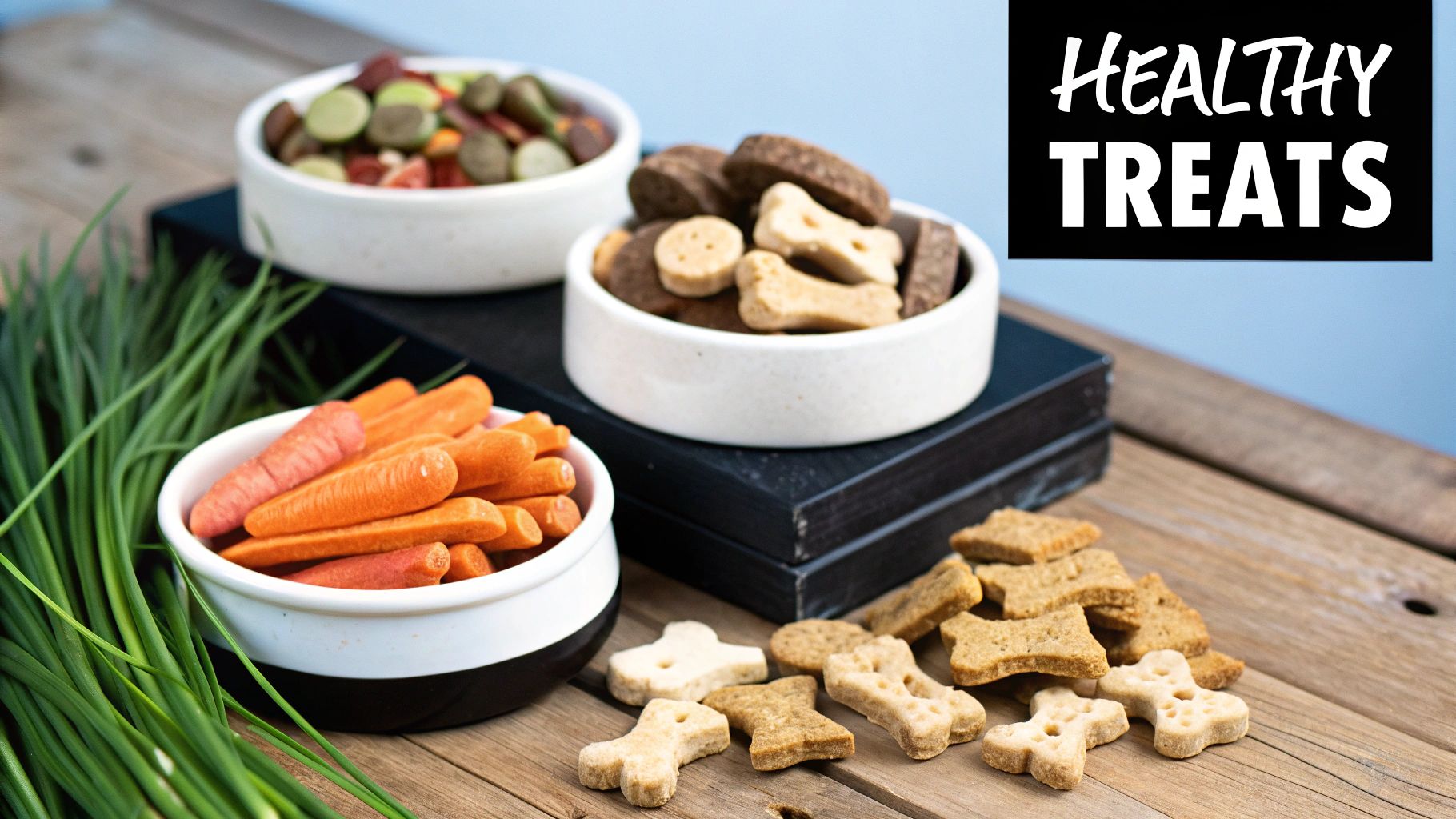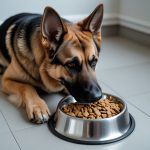A great dog feeding guide starts with one simple truth: a plan made just for your dog is always better than a one-size-fits-all approach. Every dog is an individual, and our goal is to help you create a feeding routine that truly supports their unique needs, factoring in their age, breed, and activity level.
Perfecting Your Dog’s Diet: A Journey We’ll Take Together
Welcome, fellow dog lover. Figuring out what and how to feed your dog can feel like a huge responsibility, can't it? You’re not just filling a bowl; you’re nurturing a beloved family member. It’s completely normal to want to get it absolutely right. Think of this guide as your trusted partner, here to cut through the noise with clear, practical advice.
You’re certainly not alone on this journey. Dogs are a massive part of family life here in the UK, with around 13.5 million pet dogs owned across the country. That means roughly 36% of all households share their homes with a canine friend. This incredible bond so many of us feel is exactly why getting their diet right feels so important. You can find out more about the role of dogs in UK households on thegoodkennelguide.co.uk.
Why a Personalised Plan Matters So Much
Instead of reaching for a generic solution, we’ll help you decode what your specific dog needs to thrive. Think of it as building a blueprint for their health, one meal at a time. A tailored feeding plan is vital because it directly impacts their well-being in several key ways.
A proper diet can:
- Support Healthy Growth: A growing puppy has vastly different energy and nutrient requirements than a senior dog enjoying their golden years.
- Maintain an Ideal Weight: The right portions prevent obesity and all the health problems that come with it.
- Boost Energy Levels: Good food provides the right fuel for their daily adventures, whether that’s a sprint in the park or a contended nap on the sofa.
- Promote a Shiny Coat and Healthy Skin: Nutrition is often reflected in their outward appearance – you can literally see good health.
We believe that a confident, joyful mealtime routine strengthens the bond you share. Every bowl you prepare is a step towards a long, vibrant life together. It’s an act of love, and we’re here to help you make it as effective and stress-free as possible.
What to Expect From This Guide
Our goal is to give you the practical tools and the confidence to build the best feeding routine for your companion. We'll explore everything from choosing the right type of food to understanding portion sizes and creating a consistent schedule.
We will cover the essential topics that every dog owner thinks about. This includes how to read food labels without feeling overwhelmed, how to safely switch to a new food, and what to do if your dog has special dietary needs. Let’s get started on creating a foundation of health and happiness for your dog, one meal at a time.
Understanding Your Dog's Core Nutritional Needs
Let's break down what your dog actually needs in their bowl to really thrive. We all want what's best for our furry family members, and good nutrition is the absolute foundation of a long, happy, and healthy life. It’s so much more than just filling an empty stomach; it’s about providing the essential building blocks for everything from that endlessly wagging tail to a strong, healthy heart.
Think of your dog's diet like building a house. For it to stand strong for years, you need top-quality materials. In this part of our dog feeding guide, we'll look at the core "materials" of canine nutrition, but without all the confusing scientific jargon.
The Essential Building Blocks of Their Diet
A complete and balanced diet is made up of several key components all working in harmony. Each one has a unique and vital job to do in keeping your dog in peak condition. Let's start with the "big three" macronutrients.
Protein: The Body Builder
Protein is, without a doubt, one of the most critical parts of the puzzle. Picture it as the bricks and mortar for your dog’s entire body. It’s responsible for building and repairing everything from their muscles and skin to their coat and nails. High-quality, animal-based proteins like chicken, beef, fish, and lamb are fantastic because they contain all the essential amino acids your dog’s body needs to build these structures.
Fats: The Premium Fuel Source
Fats often get a bad rap in our own diets, but for dogs, they're a crucial, concentrated source of energy. Think of healthy fats as the premium fuel that keeps their engine running smoothly and efficiently. Good fats, particularly Omega-3 and Omega-6 fatty acids, are also massive players in brain health, reducing inflammation, and giving them that beautiful, shiny coat we all love.
Carbohydrates: The Quick Energy
Carbohydrates provide readily available energy for your dog's day-to-day adventures. They are the 'quick-charge' power source that fuels those zoomies around the garden and exciting walks in the park. Good-quality sources like sweet potatoes, brown rice, and various vegetables also deliver essential fibre, which is vital for maintaining great digestive health.
Vitamins and Minerals: The Spark Plugs
So, if macronutrients are the building materials and fuel, then vitamins and minerals are the spark plugs and wiring that make the whole system work. Your dog only needs these micronutrients in small amounts, but they are absolutely essential for countless bodily functions to run correctly.
Here are just a few examples of what they get up to:
- Calcium and Phosphorus: These two work as a team to build strong bones and teeth.
- Vitamin A: This is crucial for sharp vision, a robust immune system, and healthy skin.
- Vitamin E: A powerful antioxidant that helps protect your dog's cells from damage.
- B Vitamins: This group is vital for energy metabolism, helping to convert food into usable fuel for the body.
Getting this balance right is the whole secret. Too little of one nutrient can lead to deficiencies, while too much of another can create its own set of problems. This is precisely why a "complete and balanced" commercial dog food, formulated by veterinary nutritionists, is often the safest and most reliable choice for most of us.
How Needs Change Through Life Stages
Just like us, a dog’s nutritional needs don't stay the same throughout their life; they shift and evolve as they grow up and grow old. Understanding these changes is a massive part of being a responsible owner. After all, a diet that’s perfect for a bouncing puppy could easily cause an older dog to pile on the pounds.
For a more detailed look at this, you can learn more about the specifics of canine nutrition and how it changes over time.
- Puppies (Up to 1-2 years): This is a time of incredible, rapid growth. Puppies need more calories, protein, and specific minerals like calcium to construct their growing bodies. Puppy-specific foods are carefully formulated to support this intense development phase.
- Adult Dogs (1-7 years): For adults, the main goal is maintenance. Their diet should provide enough energy for their activity level while keeping them at an ideal body weight and helping to prevent long-term health issues.
- Senior Dogs (7+ years): As dogs age, their metabolism often slows down. They typically need fewer calories to avoid weight gain but still require high-quality, easily digestible protein to maintain their muscle mass. Many senior diets also include helpful extras like glucosamine for joint support.
Portion Control: How Much Should You Feed Your Dog?
Ah, the big question every dog owner asks: just how much food should I be putting in that bowl? We’ve all been there, staring at the generic feeding chart on the back of a bag of kibble, wondering if it’s truly right for our dog. Let's be honest, those guidelines are a starting point, not the final word.
The truth is, calculating the right portion size is a bit more personal than just scooping and serving. It's about becoming your dog's personal nutritionist, and it's easier than you might think. By understanding their unique needs, we can move beyond those generic charts and create a truly tailored plan.
Beyond the Bag: Calculating Your Dog’s Calorie Needs
First things first, let's start thinking in calories, not just scoops. A cup of one brand’s food can have a very different calorie count from another. Getting this right is crucial for preventing obesity, which now affects more than half of UK dogs.
Several things influence how much energy your dog burns each day:
- Weight: A larger dog obviously needs more fuel than a smaller one, but it's not a simple linear scale.
- Age: A growing puppy's metabolism is a furnace, while a senior dog's engine runs at a much cooler pace.
- Activity Level: Is your dog a professional couch potato or your marathon training partner? Their lifestyle dramatically changes their calorie needs. A working Border Collie might need twice the calories of a chilled-out Basset Hound of the same weight.
- Neuter Status: Neutered dogs can have a lower metabolic rate, meaning they may need up to 20% fewer calories than their intact counterparts to maintain an ideal weight.
This simple chart provides a basic starting point for daily feeding amounts, but remember to adjust for your own dog's unique profile.
The real art lies in fine-tuning these amounts to match your dog's individual energy expenditure and body condition.
Now, let's look at some more specific starting points. The table below offers a rough guide for daily feeding amounts, measured in grams of typical dry kibble, based on a dog's weight and life stage.
Daily Feeding Guidelines by Dog Weight and Age
| Dog's Weight (kg) | Puppy (grams/day) | Adult (grams/day) | Senior (grams/day) |
|---|---|---|---|
| 5 kg | 120-150 g | 80-100 g | 70-90 g |
| 10 kg | 200-250 g | 150-180 g | 130-160 g |
| 20 kg | 350-400 g | 250-300 g | 220-270 g |
| 30 kg | 480-550 g | 350-420 g | 310-370 g |
| 40 kg | 600-700 g | 440-520 g | 390-460 g |
Remember, this is just a starting point. Always consult your vet and be prepared to adjust these amounts based on your dog's specific activity level, metabolism, and overall body condition.
The Best Tool You Have: Your Hands
Numbers and charts are great, but the best tool for assessing your dog's weight is one you already have: your own two hands. The Body Condition Score (BCS) is a simple, hands-on technique used by vets that you can easily do at home. It’s a regular check-in that tells you far more than the scales alone.
Think of it like this: the scales tell you your dog’s weight, but the BCS tells you if that weight is healthy. It helps you assess their fat coverage, which is a much better indicator of overall health.
Here’s how to do a quick check:
-
The Rib Check: Gently run your hands over your dog's sides. You should be able to feel their ribs easily under a thin layer of fat, a bit like the back of your hand. If you have to press hard to find them, your dog may be overweight. If the ribs are very visible and sharp, they might be underweight.
-
The Overhead View: Look down at your dog from above. You should see a defined, hourglass-shaped waist between their ribs and hips. A straight line or a bulge here suggests they are carrying extra weight.
-
The Side View: Look at your dog from the side. Their abdomen should tuck up nicely from their chest towards their hind legs. A belly that hangs low or is level with the chest is another sign of being overweight.
Performing this simple, three-step check once a month is a fantastic habit. It allows you to catch small weight changes early and adjust their food portions before it becomes a bigger health problem. You know your dog best, and this regular, tactile connection makes you the first and best line of defence in keeping them at their ideal weight.
Choosing the Best Food for Your Dog
Walking down the pet food aisle can feel pretty overwhelming, can't it? The sheer number of bags, tins, and pouches, all promising the world, is enough to make your head spin. We’re here to cut through the noise and help you navigate this maze with confidence.
Our goal is to help you see past the flashy marketing and understand what these different food options really mean for your dog's health. We'll break down the main food types so you can find the perfect match for your companion, your lifestyle, and your budget.
Decoding the Different Food Types
Every type of dog food comes with its own set of pros and cons. There’s no single "best" choice that fits every dog; the right one is simply what provides complete nutrition and works for your unique situation. Let's take a look at the main contenders you'll find on the shelves.
Dry Food (Kibble)
This is often the go-to choice, and for good reason. Dry kibble is convenient, easy to store, and usually the most budget-friendly option out there. Its crunchy texture can also do a bit of good for your dog's teeth by gently scraping away plaque.
The main thing to watch is its low moisture content. You’ll just need to make sure your dog is always drinking enough water. Some dogs, particularly the picky eaters among them, might also find it less exciting than other, more aromatic options.
Wet Food (Tinned or Pouches)
Wet food, on the other hand, has a much higher moisture content. This is fantastic for hydration and can be a lifesaver for senior dogs or those with dental troubles who find chewing difficult. Its rich smell and flavour are often a massive hit, even with the fussiest of pups.
The main downsides? It’s typically more expensive than kibble and needs to be kept in the fridge once opened. It can also be a little messier to serve up at mealtimes.
Exploring Alternative Diets
Beyond the traditional choices, you’ve probably heard about other feeding philosophies like raw and home-cooked diets. These are getting more popular as owners look for nutrition that’s more closely aligned with their dog’s specific needs.
Raw Food Diets (BARF)
Raw feeding, or BARF (Biologically Appropriate Raw Food), means giving your dog uncooked meat, bones, fruits, and vegetables. Supporters believe it’s closer to a dog’s ancestral diet and can lead to benefits like a shinier coat, cleaner teeth, and more energy.
But it’s a big responsibility. There's a risk of bacterial contamination (for both of you!) and a very real danger of creating a diet that's nutritionally unbalanced without expert help. If it’s something you’re considering, it’s vital to do your homework first. We've put together a resource to help you understand the benefits and risks of raw food for dogs in our detailed guide.
Home-Cooked Meals
Making your dog's meals from scratch gives you total control over every single ingredient. This can be a brilliant solution for dogs with severe allergies or specific health conditions that commercial foods just can't cater for.
The challenge, much like with raw diets, is ensuring nutritional completeness. Crafting a balanced home-cooked diet is a science; it’s crucial to work with a veterinary nutritionist to create recipes that meet all of your dog’s complex needs.
This desire for high-quality, specialised food is a trend across the UK. The pet food industry is a huge sector, expected to be worth around £2.75 billion in 2025 and projected to grow to over £3.2 billion by 2030. This growth isn't just because there are more dogs; it shows how much we, as owners, are investing in premium and specialised diets to keep our pets healthy and happy.
Establishing a Mealtime Routine
Like us, dogs are creatures of habit. They find a massive amount of comfort in knowing what to expect and when. This is exactly why a consistent mealtime routine is one of the most powerful tools in your arsenal. It’s not just about popping a bowl of food down; it's a daily conversation that tells your dog they’re safe, secure, and cared for.
A predictable feeding schedule does wonders for their physical health too. It helps regulate their metabolism, making it much easier to keep them at a healthy weight. Their digestive system also gets a heads-up that food is on the way, leading to better digestion and fewer upset tummies. Best of all? It can dramatically cut down on those pleading puppy-dog eyes and constant begging between meals.
Setting a Positive Mealtime Atmosphere
Where you feed your dog really matters. The goal is to build a calm, positive connection with food, turning each meal into a moment of contentment, not a source of stress or anxiety. It’s a small tweak that can make a huge difference to their wellbeing.
A few simple changes can help you create this positive vibe:
- Choose a Quiet Spot: Feed your dog in a low-traffic part of your home. You want them to be able to eat in peace, without people constantly walking past or loud noises startling them.
- Remove Distractions: If you have other pets, it’s often best to feed them separately. This simple step prevents any sense of competition or food guarding from developing.
- Stay Calm Yourself: Your dog is an expert at reading your energy. If you approach feeding time calmly and confidently, it sends a clear signal that everything is okay.
Think of mealtime as a quiet ritual you share. This consistency doesn't just benefit their digestion; it strengthens your bond and reinforces your role as their trusted provider. It’s a simple, daily way to say, "I've got you."
How to Safely Switch Your Dog to a New Food
Sooner or later, you'll probably need to change your dog's food. Whether you're levelling up their diet or managing a new health need, the secret is to go slowly. A sudden change is one of the most common reasons for digestive upset, but a gradual transition makes it a smooth, stress-free process for everyone.
We always recommend a 7-10 day transition plan. This gives your dog’s digestive system plenty of time to get used to the new ingredients.
- Days 1-3: Start with 25% new food mixed with 75% old food.
- Days 4-6: Move to a 50/50 mix of the new and old food.
- Days 7-9: Increase to 75% new food and just 25% old food.
- Day 10: You can now serve 100% of the new food.
During this time, keep a close eye on your dog. Watch for any changes in their appetite, energy, or stool quality. If you spot any issues, just slow the transition down a bit more. This gentle, patient approach is the kindest way to introduce a new diet.
Even with the best care in the world, our dogs sometimes hit a bump in the road and need a bit of extra nutritional help. Just like us, they can develop health issues where a special diet is part of the solution.
It’s completely natural to feel a knot in your stomach when you sense something isn’t right. You know your dog better than anyone. This section is all about helping you read the signs and understand when a change in their food bowl might be just what they need.
When Diet Becomes Treatment
For many common health problems, food is an incredibly powerful tool. A carefully chosen diet can help manage symptoms and genuinely improve your dog's quality of life. It’s another layer of care you can provide, right from their daily meals.
Here are a few common situations where diet plays a starring role:
- Food Sensitivities: Is your dog constantly scratching? Dealing with stubborn ear infections or an upset stomach? It could point to a food allergy or intolerance. Finding and removing the problem ingredient can bring huge relief.
- Weight Management: If your dog is struggling to keep a healthy weight—either over or under—a specialised diet is the way to go. These foods are precisely formulated with the right calorie and nutrient levels to get them back on track.
- Joint Support: For dogs with arthritis or stiffness, the right food can make a world of difference. When a condition like arthritis pops up, you might need to reconsider their diet; you can learn more about modifying your dog's diet to help with arthritis.
- Ageing Gracefully: Our senior dogs often need extra support for their changing bodies. Understanding the https://mylifemydog.com/common-senior-dogs-health-issues/ is a great first step in seeing how diet can help them thrive in their golden years.
This devotion to our dogs' health runs deep. UK pet owners are amazingly committed, with research showing that 29% of dog owners would rather skip a meal themselves than let their dog go without. It just goes to show the incredible bond we share.
Knowing When to Call the Vet
You are the expert on your dog’s day-to-day quirks and personality, but your vet is the expert on their medical health. It's vital to know which warning signs mean you should stop guessing and get professional advice straight away.
Your vet is your most important partner in your dog's health. Never, ever hesitate to get in touch if you're worried. It’s always better to get their expert opinion than to wait and wonder.
Pick up the phone and make an appointment if you spot any of these red flags:
- Persistent digestive upset (vomiting or diarrhoea that lasts more than 24 hours).
- Sudden or unexplained weight changes, whether it’s loss or gain.
- A complete refusal to eat for more than a day.
- Obvious signs of pain or extreme tiredness.
- A sudden increase in thirst or how often they need to urinate.
Your vet can run tests to get to the root of the issue and might prescribe a specialised veterinary diet. These aren't just regular foods; they are medical treatments in a bag or tin, precisely formulated to manage specific diseases. Trusting their guidance is the absolute best thing you can do for your four-legged friend.
Common Dog Feeding Questions Answered
Of course, even with the best feeding guide in front of you, you're bound to have a few lingering questions. That's completely normal—in fact, it’s a great sign. It shows you’re a caring owner who wants to do the absolute best for your furry mate.
Getting to grips with canine nutrition can sometimes feel like you need a veterinary degree, but it really doesn’t have to be that complicated. Let's tackle some of those common "what ifs" with clear, straightforward answers.
Is It Safe to Feed My Dog Human Food?
We’ve all seen those pleading eyes staring up from under the dinner table. It’s tough to resist! But while it's tempting to share, the real answer is "sometimes, and with extreme caution." A tiny piece of plain, cooked chicken or a few carrot sticks can be a lovely, harmless treat.
The problem is, so many of our everyday kitchen staples are actually toxic to dogs. Chocolate, onions, garlic, grapes, and raisins are definite no-gos. It's also vital to avoid anything containing the artificial sweetener xylitol, which is incredibly dangerous for them. To keep things simple and safe, it’s best to stick to their balanced commercial diet and use only dog-safe foods for those special rewards.
When in doubt, the safest bet is just to say no. Your dog's proper food is formulated to give them everything they need, so they truly aren't missing out.
How Can I Tell If My Dog Has a Food Allergy?
This is a huge worry for many owners, especially if you notice your dog seems uncomfortable or out of sorts. The classic signs of a food allergy aren't always digestive; more often than not, they show up on the skin.
Keep an eye out for these tell-tale symptoms:
- Constant Itchy Skin: Especially around the paws, ears, face, and tummy.
- Chronic Ear Infections: If you feel like you're treating the same ear problems over and over, an allergy could be the culprit.
- Digestive Upset: Persistent issues like vomiting or diarrhoea can also point to an allergy.
If you suspect something’s not right, your vet is your most important ally. They can guide you through a proper process, usually an elimination diet, to pinpoint the exact ingredient causing the trouble. Please don't try to diagnose or treat a potential allergy on your own—it can be a surprisingly complex puzzle to solve.
Should I Put My Dog on a Grain-Free Diet?
Grain-free diets have become incredibly popular over the last few years, but are they actually necessary? For the vast majority of dogs, the answer is no. A genuine grain allergy is surprisingly rare in the canine world. It’s far more common for a dog to have a sensitivity to a protein source, like chicken or beef.
For most dogs, healthy whole grains like brown rice, oats, or barley are a fantastic source of energy and other valuable nutrients. Unless your vet has diagnosed a specific medical reason to avoid grains, a high-quality food that includes them is a perfectly healthy and balanced choice.
At My Life My Dog, we believe that knowledge empowers you to build the best possible life for your companion. For more in-depth guides on nutrition, health, and training, explore our resources at https://mylifemydog.com and join a community of passionate dog lovers just like you.



